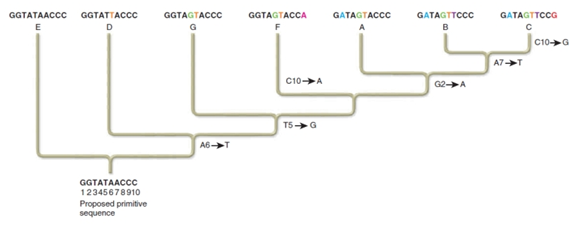What nucleotide change is a shared derived character for species A, B, and C, but not for species G?

A,T,G, and C refer to nucleotide bases, and the numbers refer to the position of the base in the nucleotide sequences.
For example, A6 refers to an adenine at the sixth position.
A. Changing the second G to an A is common to species A, B, and C, but not to species G.
B. Changing the fifth T to a G is common to species A, B, and C, but not to species G.
C. Changing the second G to a T is common to species A, B, and C, but not to species G.
D. Changing the second G to an A and the fifth T to a G is common to species A, B, and C, but not to species G.
E. None of these show a change in derived characteristics for A, B, and C that are not found in G.
A. Changing the second G to an A is common to species A, B, and C, but not to species G.
You might also like to view...
Spontaneous generation _____
A) was demonstrated to occur under normal laboratory conditions by Pasteur B) apparently occurred at least onceâ€"when life on Earth began C) occurs every time a new species evolves from a preexisting species D) addresses the formation of new cells from existing cells
An increase of lymphocytes and other mononuclear cells (pleocytosis) in the CSF and negative bacterial and fungal cultures is referred to as:
a. meningoencephalitis. b. aseptic meningitis. c. encephalitis. d. pleocytosis.
What feature do monkeys share with iguanas but not with bullfrogs?
A. eyes B. eggs C. thoracic breathing D. four-chambered heart Clarify Question · What is the key concept addressed by the question? · What type of thinking is required? Gather Content · What do you already know about reptile innovations? Choose Answer · Given what you now know, what information and/or problem solving approach is most likely to produce the correct answer? Reflect on Process · Did your problem-solving process lead you to the correct answer? If not, where did the process break down or lead you astray? How can you revise your approach to produce a more desirable result?
In plants, sporogenous cells divide by mitosis to form spores
___________________ Indicate whether the statement is true or false.